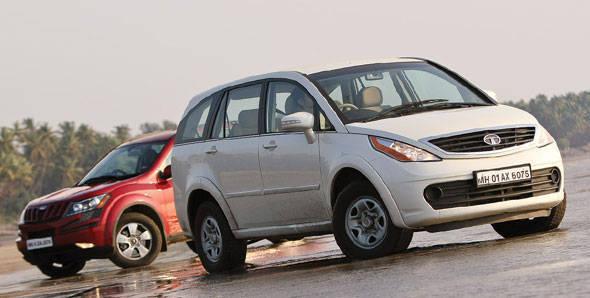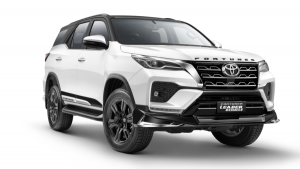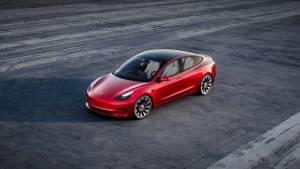Tata Aria vs Mahindra XUV500

The Tata Aria holds the distinct honour of being India's first indigenously developed crossover. But with its Rs 15.84 lakh price tag for the 4x4 Pride variant, (all prices ex-showroom, Mumbai) it was hardly going to set sales charts on fire, even with all the fancy gadgetry. But then came the de-specced Aria that gets a nearly Rs 4 lakh price cut to match the XUV's price tag.
Yet on the face of things, the XUV lands the first uppercut in terms of sheer value for money. For the price, the XUV 500 W8 comes with an exhaustively incredible amount of kit whereas the Aria Pure 4x2 costing Rs 11.85 lakh and has nothing more than a basic music system. Even the basic variant of the XUV (W6) has more kit and at Rs 10.73 lakh is much cheaper than the Aria 4x2 Pure (forget comparing with the top end 4x2 Prestige which at Rs 14.57 doesn't get ESP, curtain airbags, navigation and more). While both cars are termed crossovers, in terms of styling, the XUV looks like an SUV while the Aria looks more like an MUV.
The Aria has presence and is one of the smartest designs to come out of Tata's drawing boards in the recent past but then next to the XUV the Aria seems, for lack of a better word, plain. The Tata Aria in India is still built on the age old ladder frame chassis while the XUV is a monocoque. This means that the XUV has greater torsional rigidity and enhanced crash safety. The XUV can thus afford to use a stiffer suspension setup delivering much better handling with lesser body roll and reduced brake dive while not losing out on ride quality which is just as impressive as the Aria.
The Aria handles quite well for its size and construction but ultimately has to give way to the Mahindra. The XUV's interiors look much better than the Aria. Where Aria uses beige fabric upholstery, the XUV W8 uses leather. Where the Aria uses dull shades, the XUV uses a chocolate brown shade. This gives the XUV a fresh out of the box feel but on closer inspection a lot of minor issues crop up. For example, the wiper and light stalks feel rather cheap to operate, the rear door latch needs to be pulled three or four times to get it to open, the door locks are fidgety items and the shut lines should have been tighter. Not that the Aria is flawless the positioning of the air-con vents which freeze the driver's fists is a glaring ergonomic flaw but build issues aren't quite as obvious.
Interior space is a bit better in the Aria than the XUV, especially where the third row and boot space equation comes into play. The Aria is 195mm longer than the XUV and thus provides some more boot space behind the third row bench when the seats aren't folded. 342 litres is not much but is vastly more than the XUV's 93 litres whose third row is literally pushed against the rear hatch. The third row incidentally isn't of much use in either and is best suited for kids.
Under the hood, the Aria makes 140PS and 320Nm which is almost identical to the XUV's 140PS and 330Nm with both making the power and torque at roughly the same rpm. The Aria is loud and rackety at lower rpm, but the NVH gradually improves as the engine revs higher, sounding its quietest somewhere in the middle of the rev band. But the noise is ignorable once you realize the Aria is pretty effortless to drive, with lots of torque to play around with and minimal gearshifts.
The XUV meanwhile, might seem all peachy at first, but gets quite noisy towards the latter half of the rev band. There is also a very peculiar bubbling sound that is a constant companion when you rev the engine, and it only fades when you step off the throttle. Add to this is a slightly irritating turbo whine; and it doesn't makes for a very pleasant experience especially when the music is off. On the transmission front both the XUV and the Aria have notchy feel to the shift quality with the XUV's being slightly worse. The Aria has marginally better feel, precision and usability though with an additional ratio the XUV does make the engine more relaxed at cruising speeds.
Performance wise, the XUV does not get too far ahead of the Aria, what with the 0-100kmph sprint coming in at 12.86 seconds, 0.22 seconds quicker than the Tata's 13.08. But then this is not surprising, considering the Aria weighs 440 kilos more than the XUV. On the top speed run, the XUV clocks an impressive 183kmph while the Aria falls short at 174kmph.
While both cars feel quite stable at the top end, the XUV with its numerous electronic aids like ABS and ESP makes for a more confidence inspiring driving experience. The Aria makes do with only ABS although it needs to be noted here that in braking tests, the Aria took the shorter distance to come to standstill with a difference of two metres. Driving the Aria in the city is a bit of a struggle with its large turning radius and obvious bulk. The XUV meanwhile is surprisingly car-like in its behaviour with a turning radius that could put many a sedan to shame.
One point where the Aria clearly scores over the XUV is in terms of efficiency, especially on the highway. The Aria returns 18.7kmpl on the highway and 11.1kmpl in the city against the XUV's 16.12kmpl and 11.67kmpl respectively. So while everything else is relatively a tie, the XUV only wins by way of its price, features list and sheer value for money. It is also the more stylish vehicle, drive around in an XUV and you're sure to get noticed. But drive around in an Aria and people might flag you down assuming you're an intra-city people mover.
Starts Rs 12.23 Lakhs
2179cc
Automatic
140
320
-NA-
Related Stories
Top Stories
Latest Videos
Most Popular
- Budget Sportbike Showdown: Kawasaki Ninja 500 vs Aprilia RS 457 vs Yamaha YZF-R3
- Mumbai-Pune Expressway speed restrictions updated
- 2014 Triumph Daytona 675 vs 2024 Kawasaki ZX6R - A Decade of Evolution in Supersport Motorcycles
- 2024 Hyundai Creta vs Toyota Urban Cruiser Hyryder vs Skoda Kushaq comparison review - the hype is real?
- Nissan Magnite EZ-Shift review - is the AMT any good?














